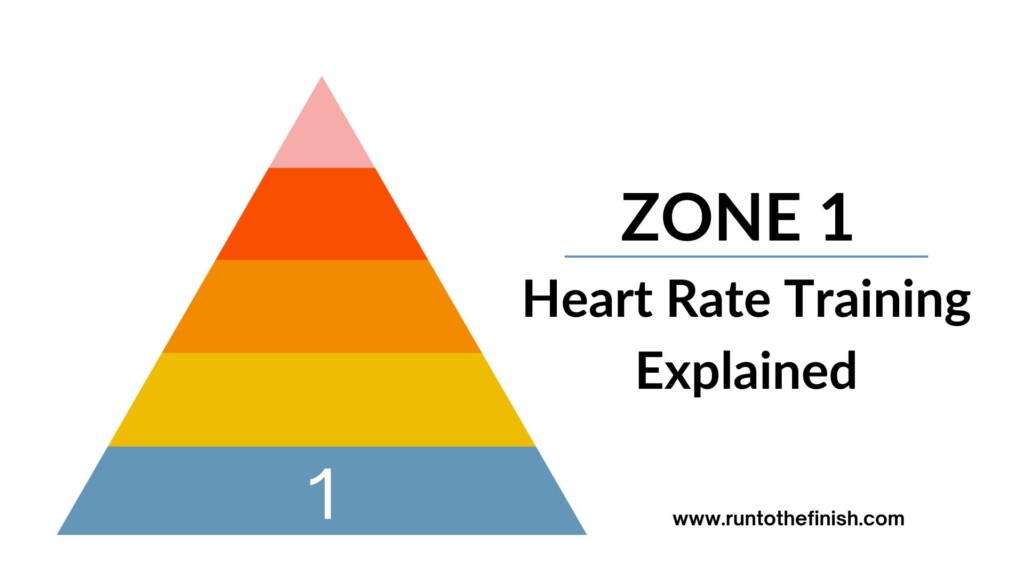Runners often talk a lot about Zone 2 training, but Zone 1 cardio is also a valuable piece of increasing your endurance and aerobic capacity. Let’s look more at how it works and where to incorporate it.
Using heart rate to guide training has become an increasingly popular and common way to monitor and guide your training effort. Over the last 12+ years as a coach, it’s a tool that I’ve helped many runners learn how to use because it allows them to break out of ego and worry about pace!
It’s also become easier thanks to nearly every smart watch, GPS watch and fitness tracker having heart rate built in to the wrist. I’ve often talked about how this may not be terribly accurate, but that’s seems to apply only as we start to move out of Zone 1.
You’ve probably heard that you should mainly workout in Zone 2. Often called the fast burning zone or the primary focus when we talk about applying the 80/20 rule of endurance training.
But what about the other zones? Specifically, what about Zone 1? How do you stay in Zone 1? What are the benefits to Zone 1? How does it fit into the bigger picture?
Stick with me and keep reading to learn all about Zone 1 because it’s absolutely an important piece of your training.
What is Zone 1 Heart Rate?
Zone 1 should be 50 to 60% of your maximum heart rate. In general, this is going to be your easiest workout pace, which isn’t to say that it’s effortless! Effortless is sitting on the couch.
This is based upon the 5 Heart Rate Zone model, which is useful for guiding your training from easy to maximum efforts in Zone 5.
- Zone 1: Active recovery workouts, walking
- Zone 2: Easy Runs, lower intensity cardio
- Zone 3: Tempo runs, often half marathon or marathon goal pace
- Zone 4: Interval training, 5K, 10K paces
- Zone 5: Sprint and high intensity interval style workouts, final moments of a race
Our goal is not to run in Zone 1, but instead to utilize it as part of our overall training. That could mean taking more walks, doing more yoga, leisurely bike rides. In fact, when we talk about the 80/20 principle of endurance training (80% of your workouts should be easy), that means both Zone 1 cardio and Zone 2!!
Too often we just think about Zone 2, but I’ve seen many 5 hour marathon runners crush their goals by adding time in Zone 1 after their runs.
Zones 1 and 2 help train our cardiovascular and respiratory systems to work more efficiently. They help teach our bodies to shuttle oxygen to our muscles better. As a result, when we head out on our high-intensity runs (i.e. race day), our bodies can perform at a higher level with less work.
How Should Zone 1 Cardio Feel?
Like Zone 2, in Zone 1 you should be able to have a conversation without needing to take pauses to take in deep breaths. But even more so. This is a walk and talk with a friend. While you might still be pumping your arms, it’s easy for you to ask questions and respond at length.
If your maximum heart rate is 180 BPM (beats per minute), 50% of that is 90. If your resting heart rate sits around 72 standing up and walking may get you to 90 beats per minute, at least for a bit. In this case, you may quickly drift in to Zone 2 as you pick up the pace and that’s ok.
You’re increasing your fitness!
Meanwhile, for long time endurance runners with a resting heart rate of 42, you might be at a brisk walk before ever reaching 90 BPM. That brisk walk could be the ticket to improving your next marathon! More on that below.
When Should You Use Zone 1?
Zone 1, because it’s 50 to 60% of your MHR, should be the zone you use when warming up, sometimes on recovery runs the day after a speed or high-intensity workout, and in rest/recoveries between intervals. Low intensity is the goal!
This is the zone you want to incorporate as you build that endurance base. Because it should feel like you could just go forever, it helps with stamina and confidence. It also allows you to exercise multiple days in a row without getting bogged down with fatigue.
You’re probably wondering though how do you stay in Zone 1? As I said earlier, if your max heart rate is 180, 50-60% of that is 90-108 bpm. Basically it’s a walk to a very slow jog. We’re not worried about breaking pace goals with Zone 1. Zone 1 should feel very, very slow for runners OR like a fast walk.
- New Runners – This is a great place to build with less frustration
- Recovery runs – easy miles that build endurance without creating fatigue
- Walking after long runs – adding time on feet without further break down, especially helpful for newer runners and back of the back marathon training
- Pre Run Warm Up and Cooldown – in both cases we are allowing the body to adjust to activity
- Active Recovery Days – Instead of power yoga or hot yoga, we’re looking to move with lower intensity!
What if just walking puts you in to Zone 2?
Don’t get too hung up on this. It’s often a sign that you are newer to cardio training and the body just takes time to adapt and build up fitness.
Overtime you should notice that with consistent daily walks, you are able to move at the same pace with a lower heart rate. Or it starts to feel easier to power walk without your HR skyrocketing.
Focus first on creating your workout habit, then as you go start to pay attention to different effort levels. Not every day should feel super intense, instead we want variety in your days.
Benefits of Zone 1 Training
Zone 2 gets all the glory, but let’s talk about why Zone 1 cardio is also beneficial.
I know it can be hard to run in Zones 1 and 2 for many athletes because it can feel so slow. But, I implore you to make peace with it! Enjoy slowing down, taking walks and feeling better all around.
Warm-Ups and Cool Downs
Zone 1, as I mentioned, is great for warmups. I know I always emphasize warm ups, but beyond the dynamic stretching, it’s important to warm up while running too, even on easy days. There’s no need to go out and jump right into Zone 2, give yourself some time in Zone 1 to ease into it.
It’s also a great zone to aim to hit as you cool down too. Slow that pace and give your heart time to come back down from the high of exercise. Walking after your run is far more valuable than the stretch.
Confidence Booster
Another benefit of Zone 1 training is that it’s great for newer runners and walkers. As I mentioned, this is a pace that you feel you should be able to do for hours and hours. That’s a great confidence builder for walkers and newer runners who are trying to run for longer periods of time.
Easy on the Body
Zone 1 also puts less stress on the body. This is important to keep your body healthy, especially if you’re slowly building your mileage. If we spend too much time at higher intensities, we can be more prone to injury.
Fat for Fuel
One other added benefit that tends to pique the interest of runners is that Zones 1 and 2 tend to help our bodies burn fat for fuel. Zones 1 and 2 are where our bodies burn the most fat when exercising, but that doesn’t necessarily correlate to weight loss. Losing fat for weight loss and burning fat for energy are two different things.
To put it simply, when we do low intensity work our bodies use fat for fuel. However, when we leave Zones 1 and 2 and enter the high intensity Zones of 3, 4, and 5 our body starts to need energy and fast and it’s easier to burn carbohydrates in the form of glycogen stores.
You might be thinking then that you just need to stick to Zones 1 and 2 for weight loss, but it simply doesn’t work that way. While you will make your body more efficient at using fat for fuel, sparing your glycogen stores for when you need them the most (like late in a race, for example), it’s not a weight loss strategy on its own.
Zone 1 is an important part of heart rate training. It’s a vital component of the 80/20 principle of endurance training, ensuring we spend enough time in low intensity effort to strengthen our cardiovascular and respiratory systems to perform better at higher intensity efforts.
Hopefully you now better understand the value of Zone 1 and low intensity efforts and how you can best incorporate it into your training regimen.
Have more training questions?
- How to Walk a Half Marathon
- Walking 3 Miles a Day for Weight Loss
- Why do Hands Swell when Walking?
- Best Walking Shoes Right Now
Other ways to connect with Amanda
Instagram Daily Fun: RunToTheFinish
Facebook Community Chatter: RunToTheFinish
Sign Up to Receive a Weekly Newsletter with Top Running Tips and Laughs



 How to Raise Metabolism Naturally: 10 Effective Methods
How to Raise Metabolism Naturally: 10 Effective Methods